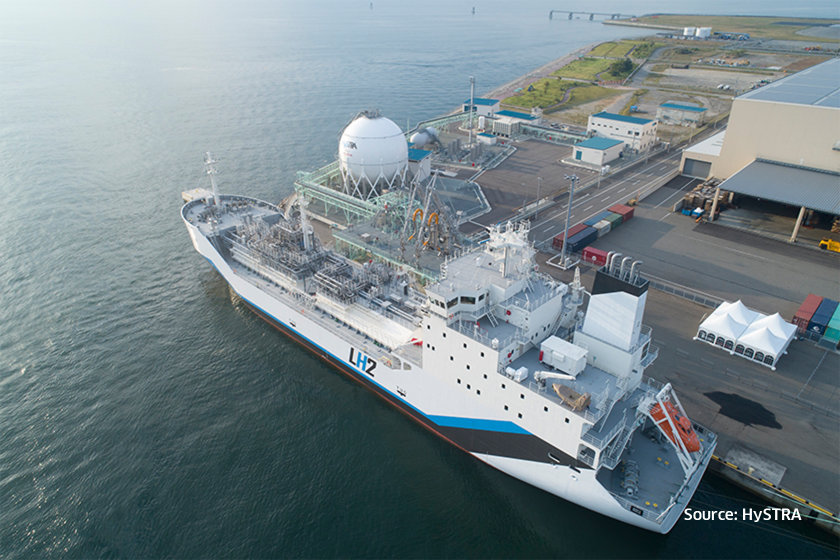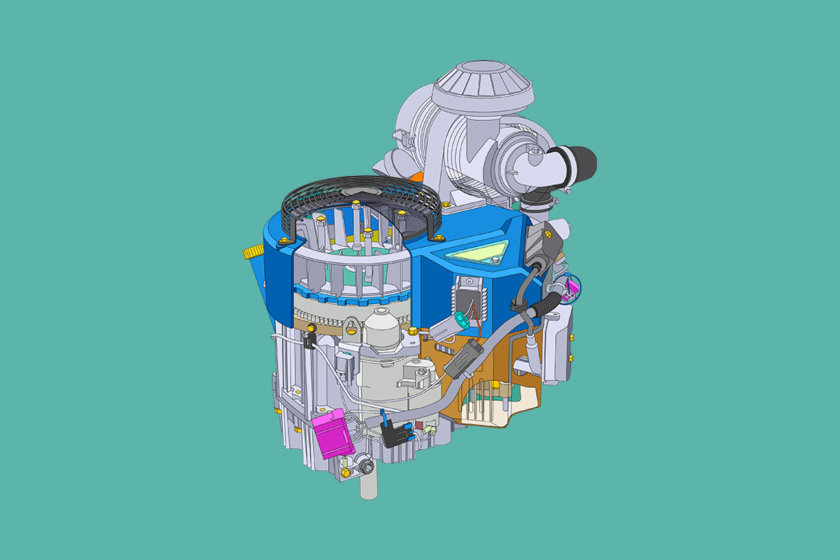The “Hydrogen Road” Has Arrived at the Demonstration Stage: A Step Forward in Realizing a Hydrogen-Based Society
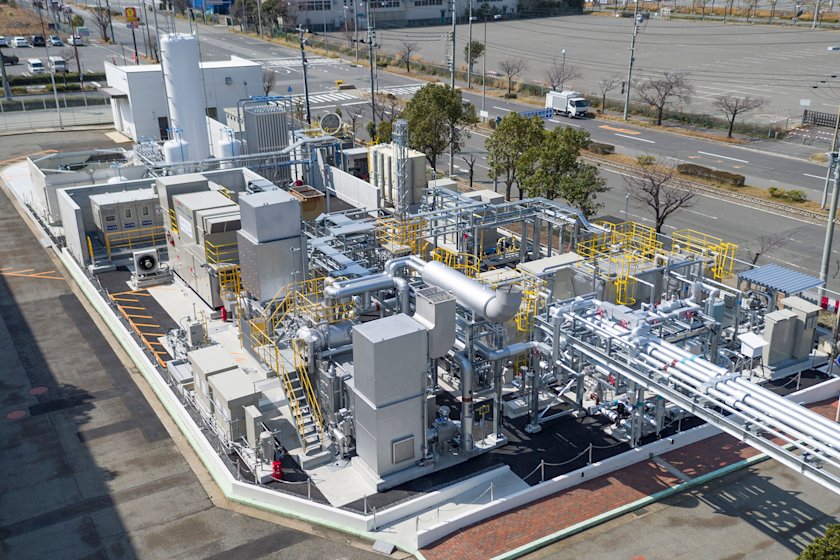
Kawasaki's four-phase process (production, transportation, storage, and utilization)
in establishing a hydrogen supply chain have seen technological advancements.
Concurrently, a vision to realize the commercialization of hydrogen-based energy is
gaining momentum at both the domestic and international levels.
Global Endeavors Begin for Promoting the Utilization of Hydrogen
It is now a fact that world leaders have begun the transition to a hydrogen economy. In January 2017, the Hydrogen Council was formed as a global initiative by 13 leading energy, transport, and industry companies with a united vision and long-term ambition to foster the hydrogen energy transition.
The Council is currently composed of Kawasaki, Toyota, Honda, Iwatani, and other Japanese companies, as well as Air Liquide (France), Alstom (France), Anglo American (U.K.), BMW Group (Germany), Royal Dutch Shell (U.K., the Netherlands), and other multinationals.
In November of the same year, the Council published a first-of-its-kind study on a globally quantified vision of the role of hydrogen. The report states that hydrogen could account for almost one-fifth of the total final energy consumed by 2050, which would reduce annual CO2 emissions by roughly six gigatons when compared to today's technologies. It also says that this volume of reduction contributes roughly 20% of the additional abatement required to limit global warming to two degrees Celsius. According to its projection, a market for hydrogen and hydrogen technologies with revenues of more than US$2.5 trillion per year and jobs for more than 30 million people globally can be achieved. In March 2018, 11 companies including 3M (U.S.) and Bosch (Germany) decided to join the Council.
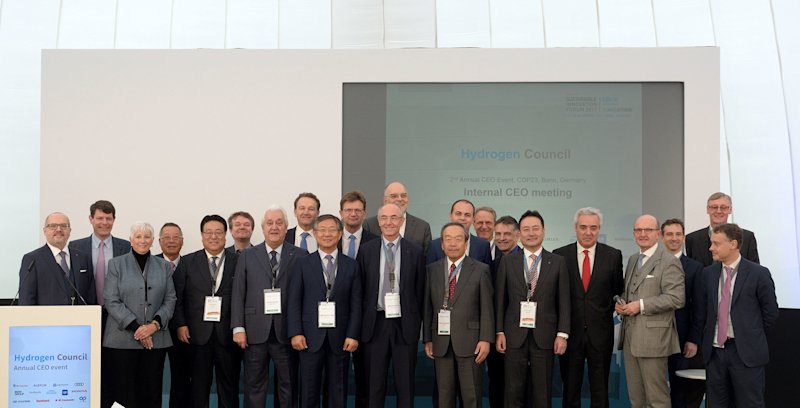
Moreover, we are seeing a global trend where governments around the world are focusing more on the use of hydrogen energy: the U.S. and EU have formulated their own hydrogen strategies, and China, the largest producer of CO2, has set national strategies on developing automobiles with a focus on hydrogen energy.
Turning our eyes to Japan, the government formulated “The Basic Hydrogen Strategy” in December 2017, which positioned hydrogen as the energy of the future that is as effective as renewable energy resources, and set forth targets to be achieved.
These targets include: 1. Increase the number of fuel cell vehicles (automobiles and buses) and hydrogen stations; 2. Aim to procure around 10 million tons of hydrogen fuel per year (equivalent to 30 GW in power generation capacity); and 3. Actively promote the use of inexpensive resources such as brown coal and renewable energies from outside the country, and for that purpose, develop an international hydrogen supply chain.
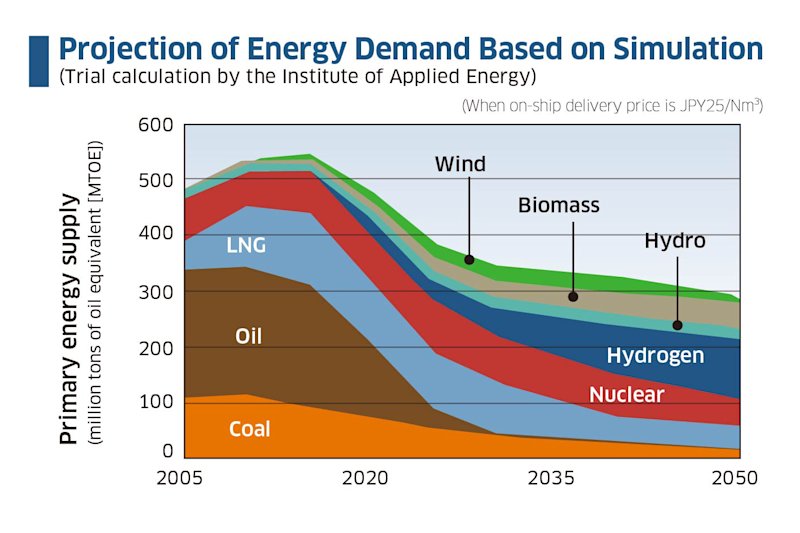
HySTRA Spearheads Technological Advancements
Even before “The Basic Hydrogen Strategy” was established, development efforts for hydrogen-related technologies were underway. In February 2016, the CO2-free Hydrogen Energy Supply-Chain Technology Research Association (HySTRA) was formed by a consortium of four companies, with the objective of launching a commercial-use hydrogen supply chain around 2030 to serve as a platform for producing, transporting, storing, and using hydrogen. The mission of this consortium, comprising Kawasaki, Iwatani, Shell Japan, and Electric Power Development (J-POWER), is to implement a pilot project subsidized by the New Energy and Industrial Technology Development Organization (NEDO) for building a hydrogen supply chain.

Each member of HySTRA assumed responsibilities as follows: 1. J-POWER would be developing a hydrogen production technology utilizing brown coal mined in Victoria, Australia; 2. Kawasaki and Shell Japan would build a liquefied hydrogen (LH2) carrier and establish a technology that enables transportation of LH2; and 3. Kawasaki and Iwatani would build LH2 handling terminals and establish technologies for operating them.
The Australian portion (led by the Federal Government of Australia and the State Government of Victoria) of NEDO's pilot project would include supporting the construction of production and liquefaction facilities for hydrogen and its handling terminals.
Kawasaki serves as a secretariat for HySTRA and is tasked not only with leading the technological development projects, but also with the coordination with the Australian government. Kawasaki's long-time efforts that began in the early 1970s in developing cryogenic and hydrogen technologies are reaching a new stage, with a focus on contribution to society.
The Hydrogen 2030 Vision, Formulated by the Hydrogen Council, Based on a First-of-Its-Kind Study
The Hydrogen Council, a global initiative for promoting hydrogen energy, released a report containing the first- ever globally quantified vision of the role of hydrogen, developed with support from McKinsey & Company. The roadmap for introducing hydrogen energy is outlined in the graph on the right. According to the report, hydrogen energy use should begin by 2030 in the power generation and transportation sectors, as well as for heating and powering buildings. By 2050, the hydrogen market is expected to increase ten-fold as compared with today, with applications extending to industrial heat use and feedstock.


Deputy General Manager
Hydrogen Project Development Center
Corporate Technology Division
Kawasaki Heavy Industries, Ltd.
Fostering a “Hydrogen-Oriented Culture” Without Over-emphasis on Technological Advancement
When Kawasaki commenced its research on hydrogen energy in 2009, driven by its conviction that hydrogen possesses great potential in becoming the pillar of transition to clean energy, there were only a handful of people who made similar forecasts. In fact, this continued until just a few years ago. Now, the world views hydrogen as a promising driver of energy transition, and the world's governments, prominent corporations, and NPOs are moving toward more fully incorporating hydrogen into their policy-making/business strategies, which clearly reflects the momentum that hydrogen energy is gaining globally.
The field of hydrogen-related technologies is often described as “multi-player realm,” in which there is no predominant corporation taking leadership, but a variety of stakeholders and businesses contribute collaboratively to develop technologies and applications, leveraging their capabilities based on their interests. Kawasaki, a company that has been spearheading this pro-hydrogen energy movement, has maintained an unrivaled belief in the bright future of hydrogen, and we confidently view ourselves as a fitting navigator for this endeavor.
With the global interest in hydrogen heightening, we are seeing some technological projects already arriving at near-completion and undergoing verification tests. Something that was conceived as a simple concept is now manifesting itself in a concrete form. As a member of the “hydrogen club,” I personally am very excited about these developments, and am always thinking about how wonderful it would be if many more initiatives could be launched.
The downside of this multi-player collaboration in developing and bringing the technologies to the verification stage, however, is that it entails fierce industry competition, necessitates the securing of technological safety at a sophisticated level, and calls for ingenious coordination among the players. We must therefore avoid over-emphasis on technological advancement, but instead work in partnership with society to build a consensus on how hydrogen energy should be commercialized, and how a "Hydrogen-Oriented Culture” can be fostered.
In that regard, global think tank research on the potential of hydrogen energy and the development of environmental performance indicators should bring about diversification, deepening, and spreading of hydrogen initiatives. Moreover, hydrogen production in Australia, verification tests at Kobe's Port Island involving a co-generation system driven by a hydrogen gas turbine, and other initiatives, should teach us not only how environmental issues can be resolved, but also how the relationship among humans, energies, and technologies can be established so comprehensively that it contributes to creating jobs, activating rural areas, and making people's lives more comfortable.
Kawasaki is aiming at establishing a hydrogen energy supply chain in cooperation with the participating HySTRA companies, with a goal of conducting pilot tests in 2020. Another goal we have is to achieve commercial use of the supply chain by 2030. To that end, we are committing ourselves to fostering a “Hydrogen-Oriented Culture” and to maturing it further.
![]() Energy and Environment
Energy and Environment![]() Energy and Environment
Energy and Environment


